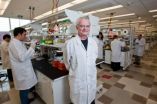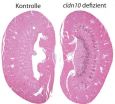'Naked Darth Vader' approach could tame antibiotic resistant superbugs
Breakthrough offers completely new way to fight bacterial infections
2012-08-23
(Press-News.org) Rather than trying to kill bacteria outright with drugs, Université de Montréal researchers have discovered a way to disarm bacteria that may allow the body's own defense mechanisms to destroy them. "To understand this strategy one could imagine harmful bacteria being like Darth Vader, and the anti-virulence drug would take away his armor and lightsaber," explained Dr. Christian Baron, the study's lead author and Professor at the Department of Biochemistry. "A naked Darth Vader would be an easy target and similarly, pathogenic bacteria without their virulence factors would be rendered harmless and eliminated by our immune system." Virulence factors are what make certain bacteria harmful to our bodies and different from most bacteria that live on our body or inside the intestinal system, which are harmless or even useful for us. Baron's research group will publish an article outlining the details of their findings tomorrow in Chemistry & Biology.
Infectious diseases caused by pathogenic bacteria were a major scourge of mankind, but thanks to the introduction of antibiotics beginning in the middle of the 20th century, most bacterial infections were largely controlled. It was a widely held belief that biomedical research had largely won the battle against these diseases. However, as antibiotics kill by targeting the essential cell functions of most (not always all) bacteria, this leads to survival of the most adaptable. "Bacteria have the capacity to develop resistance to antibiotics and they transfer this capacity to their offspring and to other bacteria. As a consequence, resistance began to emerge among the bacteria soon after the introduction of antibiotics," Baron said. In their worst forms, "superbugs" have emerged, those resistant to all but a few or even to all antibiotics."
Baron's team has discovered small molecules that target proteins in a biological system (a type IV secretion system) that is required for many bacteria to be harmful. "As if we were pulling on a loose thread in Darth Vader's cape, we have found a way to unravel the molecular details of the binding of these molecules to a target protein known as VirB8, a key part of the virulence mechanism of human and animal pathogenic Brucella species of bacteria," Baron explained. This strategy has many advantages since resistance to such treatments would likely be slow or might not even occur. Virulent bacteria could be rendered as harmless as those that live in our gut.
The concept of anti-virulence drugs still has to be proven in the clinic, but in the new battles that will arise in our war on bacteria, such drugs could prove formidable new weapons.
INFORMATION:
Notes:
The University of Montreal is known officially as Université de Montréal. The research involved in the study "Identification of the binding site of Brucella VirB8 interaction inhibitors" was financed by the Canadian Institutes of Health Research, (CIHR Grants MOP-64300 and MOP-84239), the Hans Selye Research Chair (Bristol-Myers Squibb), the FRQS-funded Groupe d'études des protéines membranaires (GÉPROM), the Canada Foundation for Innovation (CFI) and the Fonds de recherche du Québec – Santé (FRQS).
END
ELSE PRESS RELEASES FROM THIS DATE:
2012-08-23
PHILADELPHIA—It's widely accepted that molecular mechanisms mediating epigenetics include DNA methylation and histone modifications, but a team from Thomas Jefferson University has evidence to the contrary regarding the role of histone modifications.
A study of Drosophila embryos from Jefferson's Department of Biochemistry and Molecular Biology published ahead of print in Cell August 23 found that parental methylated histones are not transferred to daughter DNA. Rather, after DNA replication, new nucleosomes are assembled from newly synthesized unmodified histones.
"Essentially, ...
2012-08-23
People will reject an offer of water, even when they are severely thirsty, if they perceive the offer to be unfair, according to a new study funded by the Wellcome Trust. The findings have important implications for understanding how humans make decisions that must balance fairness and self-interest.
It's been known for some time that when humans bargain for money they have a tendency to reject unfair offers, preferring to let both parties walk away with nothing rather than accept a low offer in the knowledge that their counterpart is taking home more cash.
In contrast, ...
2012-08-23
HOUSTON, Aug. 23, 2012 – Scientists at the University of Houston (UH) have discovered what may possibly be a key ingredient in the fight against Parkinson's disease.
Affecting more than 500,000 people in the U.S., Parkinson's disease is a degenerative disorder of the central nervous system marked by a loss of certain nerve cells in the brain, causing a lack of dopamine. These dopamine-producing neurons are in a section of the midbrain that regulates body control and movement. In a study recently published in the Proceedings of the National Academy of Sciences (PNAS), ...
2012-08-23
The discovery of a 'switch' that modifies a gene known to be essential for normal heart development could explain variations in the severity of birth defects in children with DiGeorge syndrome.
Researchers from the Walter and Eliza Hall Institute made the discovery while investigating foetal development in an animal model of DiGeorge syndrome. DiGeorge syndrome affects approximately one in 4000 babies.
Dr Anne Voss and Dr Tim Thomas led the study, with colleagues from the institute's Development and Cancer division, published today in the journal Developmental Cell.
Dr ...
2012-08-23
Sodium chloride, better known as salt, is vital for the organism, and the kidneys play a crucial role in the regulation of sodium balance. However, the underlying mechanisms of sodium balance are not yet completely understood. Researchers of the Max Delbrück Center for Molecular Medicine (MDC) Berlin-Buch, Charité – Universitätsmedizin Berlin and the University of Kiel have now deciphered the function of a gene in the kidney and have thus gained new insights into this complex regulation process (PNAS Early Edition, doi/10.1073/pnas.1203834109)*.
In humans, the kidneys ...
2012-08-23
They are one of the most destructive forces of nature on Earth, but now environmental scientists are working to tame the hurricane. In a paper, published in Atmospheric Science Letters, the authors propose using cloud seeding to decrease sea surface temperatures where hurricanes form. Theoretically, the team claims the technique could reduce hurricane intensity by a category.
The team focused on the relationship between sea surface temperature and the energy associated with the destructive potential of hurricanes. Rather than seeding storm clouds or hurricanes directly, ...
2012-08-23
Vancouver, BC – August 23, 2012 – Vancouver-based clinician and researcher Dr. Andrei Krassioukov is packing for the upcoming Paralympic games in London. Rather than packing sports equipment, he has a suitcase full of advanced scientific equipment funded by the Canada Foundation for Innovation that he will use to monitor the cardiovascular function of athletes with spinal cord injuries.
Up to 90% of people with injuries between that cervical and high thoracic vertebrae suffer from a condition that limits their ability to regulate heart rate and blood pressure. For top-level ...
2012-08-23
Scientists at the University of Cambridge have produced hydrogen, H2, a renewable energy source, from water using an inexpensive catalyst under industrially relevant conditions (using pH neutral water, surrounded by atmospheric oxygen, O2, and at room temperature).
Lead author of the research, Dr Erwin Reisner, an EPSRC research fellow and head of the Christian Doppler Laboratory at the University of Cambridge, said: "A H2 evolution catalyst which is active under elevated O2 levels is crucial if we are to develop an industrial water splitting process - a chemical reaction ...
2012-08-23
CAMBRIDGE, MA -- The discovery of graphene, a material just one atom thick and possessing exceptional strength and other novel properties, started an avalanche of research around its use for everything from electronics to optics to structural materials. But new research suggests that was just the beginning: A whole family of two-dimensional materials may open up even broader possibilities for applications that could change many aspects of modern life.
The latest "new" material, molybdenum disulfide (MoS2) — which has actually been used for decades, but not in its 2-D ...
2012-08-23
ARLINGTON, Va.—The Office of Naval Research (ONR) is demonstrating the next phase of an augmented-reality project Aug. 23 in Princeton, N.J., that will change the way warfighters view operational environments—literally.
ONR has completed the first year of a multi-year augmented-reality effort, developing a system that allow trainees to view simulated images superimposed on real-world landscapes. One example of augmented reality technology can be seen in sports broadcasts, which use it to highlight first-down lines on football fields and animate hockey pucks to help TV ...
LAST 30 PRESS RELEASES:
[Press-News.org] 'Naked Darth Vader' approach could tame antibiotic resistant superbugs
Breakthrough offers completely new way to fight bacterial infections

